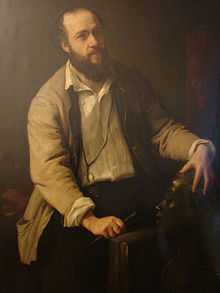Charles Cordier
| Charles Cordier | |
|---|---|
 Charles Henri Joseph Cordier | |
| Born |
19 October 1827 Cambrai |
| Died |
30 May 1905 (aged 78) Algiers |
| Nationality | French |
| Education | École des Beaux-Arts |
| Known for | Sculpture, Painting |

Charles Henri Joseph Cordier (19 October 1827 - 30 May 1905) was a French sculptor of ethnographic subjects.
Career
Cordier was born in Cambrai. In 1847, a meeting with Seïd Enkess, a former black slave who had become a model, determined the course of his career.[1]
His first success was a bust in plaster of a Sudanese man "Saïd Abdullah of the Mayac, Kingdom of the Darfur" (Sudan). This was exhibited at the Paris Salon of 1848, the same year that slavery was abolished in all French colonies. It is now housed at the The Walters Art Museum.
In 1851, Queen Victoria bought a bronze of it at the Great Exhibition of London.
From 1851 to 1866, he served as the official sculptor of Paris's National History Museum, creating a series of spectacularly lifelike busts for their new ethnographic gallery (now housed in the Musee de l'Homme, Paris).
Cordier took part in the great works commissioned by the Second French Empire (Paris Opera, Musée du Louvre, the Hôtel de Ville) or by private interests such as Baron de Rothchild. He died in Algeria.
Bibliography
- Laure de Margerie, Édouard Papet & al. Facing the other: Charles Cordier (1827–1905), ethnographic sculptor. New York: Harry N. Abrams, 2004. ISBN 0-8109-5606-3
- Pierre Dalibard c'était le temps où Charles Cordier unissait l'onyx et le bronze. Éditions Tensing, 2012. ISBN 978-2-919750-11-5
References
| Wikimedia Commons has media related to Charles Henri Joseph Cordier. |
- ↑ Described in his Mémoires, Musée d'Orsay exhibition from 3 February 2004 to 2 May 2004, Facing the other : Charles Cordier, ethnographic sculptor, page 5.
External links
|